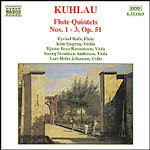
Kuhlau: Flute Quintets Op. 51, Nos. 1-3
 $25.00
Low Stock
add to cart
$25.00
Low Stock
add to cart
FRIEDRICH KUHLAU
Kuhlau: Flute Quintets Op. 51, Nos. 1-3
Eyvind Rafn (flute) with Kim Sjogren (violin) Georg Svendsen Andersen (viola) Bjarne Boye Rasmussen (viola) Lars Holm Johansen (cello)
[ Naxos / CD ]
Release Date: Monday 26 July 2004
Should this item be out of stock at the time of your order, we would expect to be able to supply it to you within 2 - 5 business days.
"Flautist Eyvind Rafn and his Danish group present an alert, well-balanced ensemble, with clear textures and stylish phrasing that demonstrate their evident enthusiasm for this music"
- Gramophone
Friedrich Kuhlau was known to his contemporaries as the Beethoven of the flute and although his many sonatas, variations, duets, trios, quartets and quintets making use of the flute cannot all be said to be of the same importance and merit to stand comparison with Beethoven's chamber music, it is nevertheless true to say that hardly any other composer has written so much good music for the flute as Kuhlau. He was, moreover, a great admirer of Beethoven and the two became friends when they met in Vienna.
Kuhlau himself wrote in 1813 suggesting that he only played the flute a little but claiming intimate knowledge of the instrument. In 1829 he painted a darker picture, writing that he could not even put his fingers correctly in the simplest position on the instrument. Nevertheless he w rote no less than sixty works for the flute, one of the most popular instruments of the time, while allowing his friend, the Court Musician P. C. Bruun, flautist in the Royal Orchestra, to look through his manuscripts before their publication.
Born in the German town of Uelzen, near Hanover, on 11th September 1786, Kuhlau was the son of a regimental musician and his father gave him some instruction on the flute. He wen! on to study piano and composition in Hamburg with some of the best teachers of the day, there mastering the techniques of composition.
By 1810 Napoleon had conquered much of Europe and when Kuhlau learned that his name was on the recruiting list for Napoleon's army, although he had lost his right eye as a child when he fell in the street with a bottle in his hand, he fled as fast as he could to Copenhagen, where he settled under the name of Kasper Meier. There, in January 1811, he gave his first concert, appearing as soloist in his own Piano Concerto in C major, composed in Hamburg. The newspaper Vagen (The Day), writing about the concert, described Kuhlau as a tall young man, whose strong bony figure looked rather awkward in his black clothes. The writer went on to describe Kuhlau's ruddy face, disfigured by the 1055 of the right eye, but otherwise giving the impression of open straightforwardness, a slight contrast with a noticeable clumsiness in his movements, for a certain harmony in his outward appearance seemed lacking.
Kuhlau quickly established a connection with the court and with the Royal Theatre and went on to exercise considerable influence over the musical life of Copenhagen, where he worked to spread a knowledge of the new music of the day, by composers such as Beethoven, Cherubini, Spohr and Weber, something much resented by Weyse, among others. He was also a warm admirer of the music of Mozart, as many of his own compositions bear witness.
Tracks:
Flute Quintet No. 1 in D major, Op. 51
Flute Quintet No. 2 in E major, Op. 51
Flute Quintet No. 3 in A major, Op. 51

